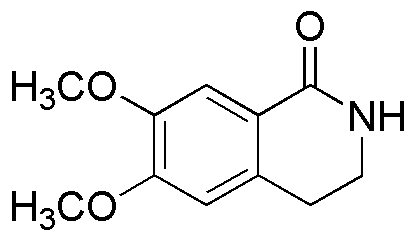6,7-Dimethoxy-3,4-dihydro-2H-isoquinolin-1-one is widely utilized in research focused on:
- Pharmaceutical Development: This compound is explored for its potential therapeutic effects, particularly in developing drugs targeting neurological disorders due to its ability to interact with specific receptors in the brain.
- Natural Product Synthesis: It serves as a valuable intermediate in the synthesis of various natural products, enabling researchers to create complex molecules that may have beneficial biological activities.
- Biochemical Research: The compound is used in studies investigating enzyme inhibition and receptor binding, providing insights into metabolic pathways and cellular functions.
- Analytical Chemistry: It can be employed as a standard in chromatographic techniques, aiding in the identification and quantification of similar compounds in complex mixtures.
- Cosmetic Formulations: Due to its antioxidant properties, it is being researched for inclusion in cosmetic products aimed at skin protection and anti-aging benefits.
General Information
Properties
Safety and Regulations
Applications
6,7-Dimethoxy-3,4-dihydro-2H-isoquinolin-1-one is widely utilized in research focused on:
- Pharmaceutical Development: This compound is explored for its potential therapeutic effects, particularly in developing drugs targeting neurological disorders due to its ability to interact with specific receptors in the brain.
- Natural Product Synthesis: It serves as a valuable intermediate in the synthesis of various natural products, enabling researchers to create complex molecules that may have beneficial biological activities.
- Biochemical Research: The compound is used in studies investigating enzyme inhibition and receptor binding, providing insights into metabolic pathways and cellular functions.
- Analytical Chemistry: It can be employed as a standard in chromatographic techniques, aiding in the identification and quantification of similar compounds in complex mixtures.
- Cosmetic Formulations: Due to its antioxidant properties, it is being researched for inclusion in cosmetic products aimed at skin protection and anti-aging benefits.
Documents
Safety Data Sheets (SDS)
The SDS provides comprehensive safety information on handling, storage, and disposal of the product.
Product Specification (PS)
The PS provides a comprehensive breakdown of the product’s properties, including chemical composition, physical state, purity, and storage requirements. It also details acceptable quality ranges and the product's intended applications.
Certificates of Analysis (COA)
Search for Certificates of Analysis (COA) by entering the products Lot Number. Lot and Batch Numbers can be found on a product’s label following the words ‘Lot’ or ‘Batch’.
*Catalog Number
*Lot Number
Certificates Of Origin (COO)
This COO confirms the country where the product was manufactured, and also details the materials and components used in it and whether it is derived from natural, synthetic, or other specific sources. This certificate may be required for customs, trade, and regulatory compliance.
*Catalog Number
*Lot Number
Safety Data Sheets (SDS)
The SDS provides comprehensive safety information on handling, storage, and disposal of the product.
DownloadProduct Specification (PS)
The PS provides a comprehensive breakdown of the product’s properties, including chemical composition, physical state, purity, and storage requirements. It also details acceptable quality ranges and the product's intended applications.
DownloadCertificates of Analysis (COA)
Search for Certificates of Analysis (COA) by entering the products Lot Number. Lot and Batch Numbers can be found on a product’s label following the words ‘Lot’ or ‘Batch’.
*Catalog Number
*Lot Number
Certificates Of Origin (COO)
This COO confirms the country where the product was manufactured, and also details the materials and components used in it and whether it is derived from natural, synthetic, or other specific sources. This certificate may be required for customs, trade, and regulatory compliance.


